Why Trust Gadgetbyte?
At Gadgetbyte, we invest substantial hours into rigorously testing each product or service we review, guaranteeing that you make informed purchases. Learn more about our testing process.
Review Overview
Design & Build
9/10
Display
9/10
Audio
9/10
Connectivity
9/10
Software
8/10
Remote
9/10
Value for Money
9/10
Samsung TU8000 55" 4K TV brings a warm blend of premium design, excellent display quality, terrific audio, and everything else you'd expect from a great TV. From the auto low-latency mode for console gaming to the Ambient Mode, it also brings a couple of features you'd find on a premium Samsung TV.
When it comes to TVs, Samsung is one of the best. About a year ago, we reviewed Samsung’s RU7100 55” 4K TV which was remarkable for the price. From its design, display, audio, to practically every aspect, it left a good impression. And here in Nepal, the company recently launched its successor in the form of the TU8000 series. Actually, there is TU7100 series in other markets in the world which is the proper heir to the RU7100. But that’s not available here. However, the good news is that the objectively superior TU8000 has been priced competitively coming from its predecessor. Allow me to discuss all about the Samsung TU8000 55" 4K TV in this review.
Samsung TU8000 55" 4K TV Specifications:
- Display: 55-inches LED-backlit LCD, PurColor technology
- Resolution: 4K Ultra-HD (3840 x 2160 pixels)
- Dimensions:
- Without stand (W x H x D): 48.4 x 27.8 x 2.4-inches
- With stand (W x H x D): 48.4 x 30.8 x 9.9-inches
- Weight: 13.88 kg (without stand) | 14.20 kg (with stand)
- Sound: 2x Speakers (2CH) with 20W Output (RMS)
- Audio Decoder: Dolby Audio
- OS: Tizen OS (SmartThings app support)
- Processor: Crystal Processor 4K
- HDR: Yes (HDR, HDR10+, HLG)
- Refresh Rate: 60Hz, Motion Rate 120, ALLM
- Viewing Angle: Standard
- Power: AC220-240V 50/60Hz (140W)
- Wireless Connectivity: WiFi 802.11 ac (dual-band), Bluetooth 4.2
- I/O Ports: 3x HDMI (including one HDMI ARC), 2x USB 2.0, 1x Ethernet (LAN), 1x Composite AV (in), 1x Digital Audio Out (Optical), 1x RF in
- Remote: One Remote (battery included inside the box)
- Warranty: 2 years (panel, service)
- Price in Nepal: Rs. 107,390 103,000
- Buy here (Samsung Plaza)
Samsung TU8000 55" 4K TV Review:
Design & Build
- 3-side minimal bezels, plastic back panel
- Can be wall-mounted or installed using a stand
Let’s start with the design. As one can tell, Samsung has really delivered a modern design on this TV. Because the bezels are marginally slim all around, the TU8000 ends up looking way more premium than the competition in this arena. Putting it side-by-side against Xiaomi’s Mi TV 4X 55, barring the bottom bezels, the remaining ones are almost non-existent here. Although this TV costs around 1 lakh here in Nepal because of customs, it falls under Samsung’s mid-range lineup. Nevertheless, this commitment towards a premium design language is exemplary.
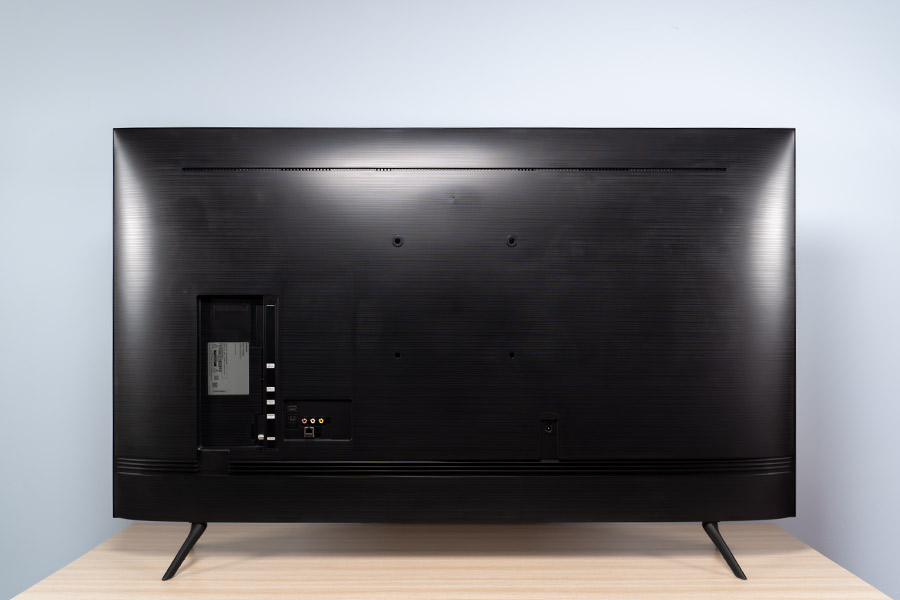
Just like the RU7100, its frames are entirely made from plastic. Yet, the rear panel comes in this matte finish and doesn’t look that bland. But that’s neither here nor there since that portion of the TV doesn’t factor-in in your viewing experience. More on the design, we can’t ignore cable management. To ensure a cleaner setup, the back of the TV has 4 dedicated horizontal spaces where you can tug in the wires. And if you choose to install it table-top style, the included clips can be used to hold the cables onto the leg stand for a minimalistic look.
Moving on, on top of the table-top mount, you can also set it up on your wall for that seamless aesthetics. Because the Samsung TU8000 has such a sleek design, I’d advise on this installation method. Besides this, there’s one more reason to opt for a wall-mount fit, which I’ll get into in just a bit. Regardless, the V-shaped plastic legs are sturdy on themselves and can reliably hold the TV in place.
Display
- 55" 4K UHD LED-backlit LCD (VA panel)
- HDR content compatible (HDR, HDR10+, HLG)
- 60Hz refresh rate, Motion Rate 120, ALLM
In terms of display, this is a 55” 4K LED TV from Samsung with a VA panel. At this point, it’s safe to say that Samsung knows how to make a good display and that tradition follows suit with the TU8000. You may know that to simplify a TV’s quality, the company rates its UHD or higher model TVs a PQI (Picture Quality Index) value. Based on different factors like colors, contrast, saturation, dimming, motion blur, etc., one can infer a brief idea about the quality of a certain Samsung TV.
Coming from RU7100’s 1400 PQI, 2020’s TU8000 boasts a 2100 PQI. The main factors contributing to this bump are colors, contrast, and motion rate. In terms of colors, TU8000 is infused with Samsung’s Crystal technology that emphasizes making adjustments in secondary colors to produce as close-to-natural hues as possible. Disappointingly, just like 2019’s RU7100, you’re still not getting Wide Color Gamut (WCG) here and I think Samsung has missed a mark in this area.
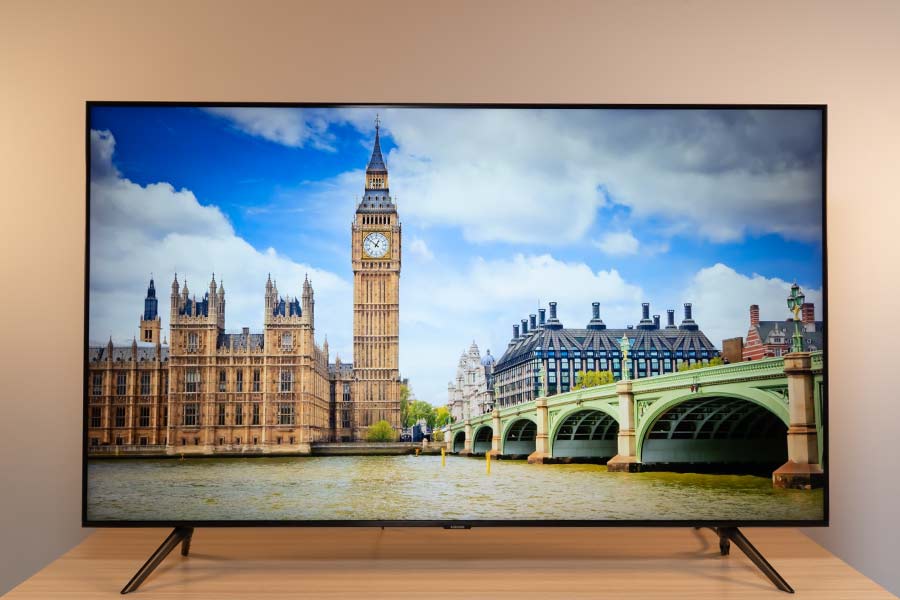
Usually, this color-enhancing feature comes bundled with HDR technology but the company seems to be fixated on exclusivizing it on higher-end TVs only. More specifically, WCG is capable of producing over a billion colors, thereby delivering an even more immersive viewing experience. Still and all, unless you put the TU8000 alongside one with WCG, it’s hard to tell the difference to an untrained eye.
Contrast Enhancer
Anyway, as I mentioned earlier, this TV uses a VA panel. As a result, it has excellent contrast, and watching HDR content is a blast. Taking it a step further is a feature called “Contrast Enhancer” that delivers even darker darks. While we’re talking about HDR, it’s also worth mentioning that TU8000 automatically recognizes HDR content and changes the picture quality to HDR mode. This switch can be visualized under the picture mode settings.
For a dynamic use case, you can choose from 5 different picture modes – dynamic, standard, natural, movie, and Filmmaker. The latter’s an interesting one. Usually, high-end TVs enable motion-smoothing settings by default without an explicit way to disable them. While this feature is plenty useful when watching fast-paced content like sports, regular 24/30fps programs, sitcoms, movies come off looking abnormally smooth—ruining the experience altogether. So, Samsung alongside other TV manufacturers collaboratively developed this standard which disables a TV’s inherent motion smoothing.
This is a blessing for casual users who don’t tend to mess around the settings. Because OEMs don’t provide a clear-cut option to switch it off, most people might simply adjust to the discomfort. Plus, it doesn’t help that general consumers aren’t aware of a TV’s motion rate or judder settings. So here, enabling the Filmmaker mode disables the Motion Rate 120 on TU8000, while also dimming the backlight and minimizing the contrast by a bit. But if you want to turn off motion smoothing under other presets, that’s possible too. Simply bring down the judder value to your level of comfort in the selected picture mode.
Gaming mode
Likewise, if you’re a console gamer and would like to use your TV as the output, Samsung TU8000’s ALLM (Auto Low Latency Mode) is also something to cherish. Basically, it automatically optimizes settings like input lag, motion blur, and judder whenever the TV detects a viable input source. Therefore, you’ll be able to enjoy smoother gaming on this TV.
If you end up installing the TU8000 in a bright room that enjoys plenty of ambient light, then I’d suggest you opt for the dynamic picture mode. Compared to the rest, this one bumps brightness to the max, while also offering a cooler color science. But then again, you can customize each of those settings as you’d like. From brightness, contrast, sharpness, color tone, to tint level, you can really customize your TV. What’s more impressive is that all of this is possible with a live preview of the effect—meaning you don’t need to make rounds to the settings menu for each tweak to see how it ends up looking.
[caption id="attachment_98350" align="alignnone" width="900"]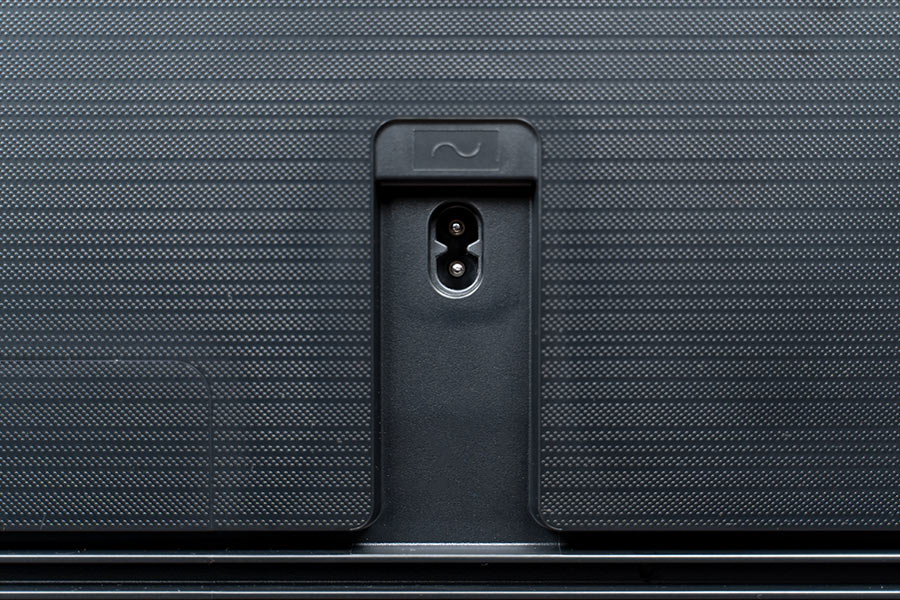
Besides this, brightness and sharpness are excellent on this TV as well. It does have a semi-glossy panel so you’d want to place it in a room with a relatively less light source. I didn’t notice any sort of backlight bleeding on the Samsung TU8000’s display either. However, I do have one complaint on the display front, which is the viewing angles. Looking at it from the side, one will notice a noticeable drop in saturation and contrast levels. Even when sitting about 2 – 2.5 meters apart, there is a slight dip in the aforementioned aspects. As a result, maintaining central seating is crucial for the optimal viewing experience on this TV.
Audio
- 2CH speakers with 20W (RMS) output
Let’s get to the audio now. Like the RU7100, Samsung has gone with a 2CH down-firing speaker setup which has a 20W RMS output. And I must say, I really like its sound quality. It also supports uncompressed Dolby Audio but for that, you’ll need a 5.1/7.1 channel Dolby Audio compatible soundbar or a home theater system that takes an HDMI ARC connection. Unfortunately, we didn’t have one lying around and couldn’t test it out.
Nevertheless, the internal speakers on the TU8000 are more than enough to rock your average-sized living room. Now I know this experience doesn’t compare against a home theater system when it comes to immersiveness. However, contrary to the centered audio projection in ordinary TVs, this one has a more distributed implementation. I don’t mean to draw comparisons to a 360-degree audio system but I strongly feel like its internal speakers suffice the needs of non-audiophiles.
Multiple audio presets
For added immersiveness, you can also select the “Adaptive” audio preset which optimizes the sound quality on a scene-by-scene basis. If you want to drown out the ambient noise, then “Amplify” mode is what you’d want. Additionally, there’s also the option to mess around with the equalizer settings for fine-tuned audio. But this is available under the “Standard” sound profile only. In terms of bass, I wasn’t expecting much, to begin with, but hints of mild thump every-now-and-then was a surprise. Because of this, the audio quality isn’t entirely flat compared to other TVs.
Moreover, the vocals and mids sound clear and crisp too. Also, if you’re mostly into TV shows, sitcoms, and movies, or similar contents, the “Dialog Enhancement” feature makes sure that the vocals sound a lot clearer as well. Even cranking up the loudness to the max doesn’t distort the audio by much which is fantastic.
Connectivity
- Decent wired connectivity options
- SmartThings, Apple AirPlay compatible
On the connectivity front, Samsung TU8000’s input/output port selection is pretty decent. There are 3 HDMI ports altogether that support 4K resolution throughput at 60Hz. As I mentioned earlier, one of those is ARC (Audio Return Channel) compatible which lets you route uncompressed audio to/from compatible devices. Besides this, you get two USB 2.0 Type-A, one AV in, one RJ45 (LAN), and one digital audio out (optical) connection.
Review Images
1/2
Shifting our gears to wireless connectivity, this TV is equipped with Wi-Fi ac and Bluetooth 4.2. If you mostly tend to stream 4K contents, then the wired route is the one to go. That’s because streaming high-bandwidth content over a wired connection is usually riddled with frequent buffers. If you have a solid Wi-Fi setup, this is not a problem but in most Nepali households, that’s not the case. Here, you can even stream music from your phone on the TV via something called “Music System/ Two way sharing”. This basically transforms your TV into a speaker and you can even turn off the screen altogether to just enjoy the music—while also saving up on power consumption.
If you’re own a Samsung smartphone, the TU8000 is also better optimized for such devices. Using the SmartThings app, you can easily cast the content of your phone to the TV by enabling the “Tap view” option. Simply tap your phone to the TV, and voilà. And to those in the Apple ecosystem, its AirPlay support means you can stream audio, video from your iPhone, iPad, or Mac to this TV.
Software
- Samsung Tizen OS
- Multiple voice assistants
Okay, let us now get into the software side of things. Samsung TU8000 is a smart TV but unlike most of those in the market, it doesn’t run on the Android platform. Rather, it operates on Samsung’s own Tizen OS which is really well designed and optimized. It is powered by the new Crystal Processor 4K that further enhances the UI/UX. Plus, thanks to the floating window, getting through the system menus and settings is void of any hassle as well.
The home button on the remote opens up different items like installed apps and other assorted settings. Netflix, YouTube comes pre-installed and can’t be uninstalled. You can download other necessary apps from the app store but unfortunately, the app selection isn’t quite as extensive as the ones on Android TV. Having said that, the most fundamental TV apps like Amazon Prime Video, Disney+, YouTube Kids are readily available here so it won’t be much of an issue to everyone.
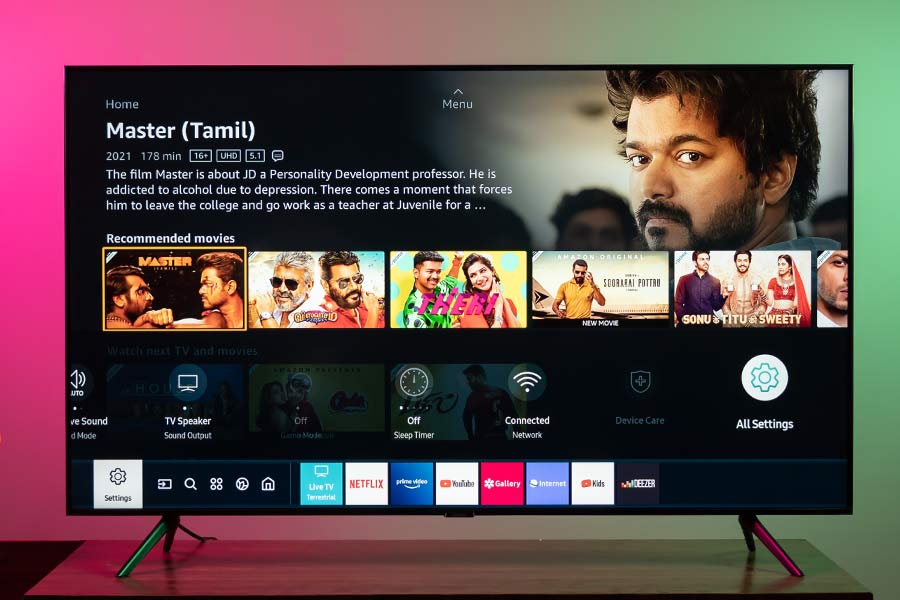
If you recall, I’d praised how you get a live preview of any-and-all display settings you changed on the TU8000. This contrasts with how Android TVs have this stiff menu layout where it requires you to revisit the settings menu in case you don’t like the new change. In terms of a digital assistant, there are 3 options altogether. Samsung’s own Bixby handles most operations ranging from volume control to browsing the web, whereas it also includes support for Google Assistant and Amazon Alexa.
The Frame's Ambient Mode
Another exciting software feature on this TV is the “Ambient Mode”. Remember how I said you’re better off wall-mounting it? Yeah, this is why. Borrowed directly from the company’s “The Frame” lineup of art TVs, it lets you remold the TU8000 into an art décor. It's not that this feature doesn’t work under table-top mount, but it’s just that the execution looks much more seamless under the wall-mount state. So, how do you use it? That’s pretty simple.
Just press the dedicated ambient mode on the remote or select it from the home menu. You can choose from different artworks, background themes to best reflect your taste in art—or just have something that blends with the room. You can also adjust the brightness level, saturation, RGB tone, and other settings to personalize the ambient mode experience. Because it minimizes the backlight level by a significant level, you won’t have to worry about the added energy cost of having the TV turned on at all times either.
Remote
- Minimalistic Samsung One Remote
Finally, allow me to discuss the remote. Compared to the one from 2019’s RU7100, Samsung’s One Remote hasn’t seen a considerable change in design language. It is still as minimalistic as ever and the tactile feedback is incredible too. The One Remote is comfortable to hold and also gains a bit of heft with the battery installed. With this, it doesn’t end up feeling too light and cheap.
There are 14 buttons altogether whose feedback is equally impressive and not-at-all plasticky. For quick access, you get a dedicated Netflix, Amazon Prime, and web browser buttons too. There are two buttons that can be pushed up/down for changing volume and channel. Although it doesn’t have a separate mute button, you can shush the volume by pressing the volume toggle button. On top of this, it has a separate microphone button to interact with the voice assistant as well.
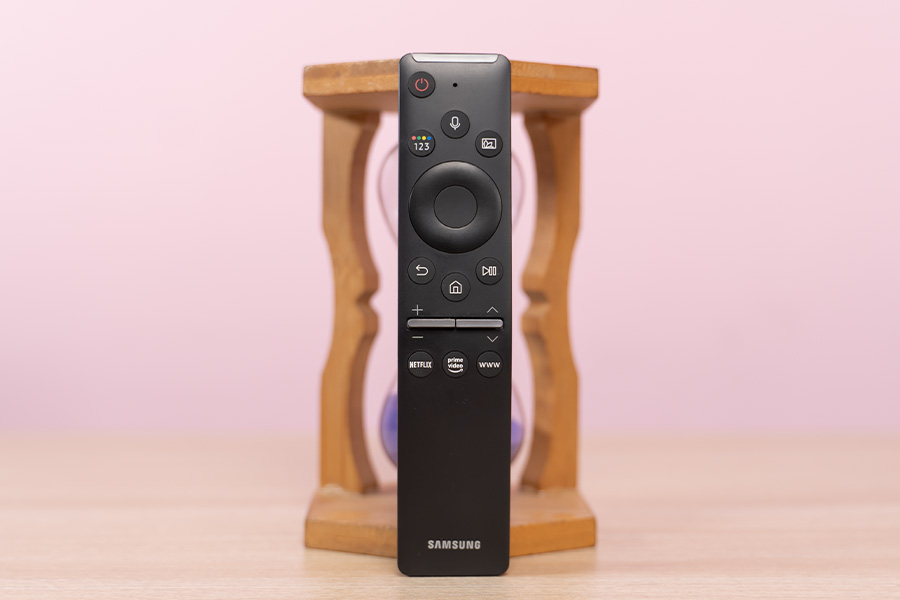
The only difference between One Remote on RU7100 and TU8000 is the ambient mode button, which was missing in the former. All in all, this remote is really handy and is quite easy to operate. Also, if you accidentally happen to misplace it, then you can even use your phone as a remote via the SmartThings app.
Conclusion
Wrapping up this review, the Samsung TU8000 55” 4K TV is an excellent option for those who are looking for a premium TV experience. From its design, display, UI/UX to the audio quality, everything is top-notch here. And it’s quite commendable how the company has tried to embed premium features on this mid-range TV. As usual, Samsung TVs cost a pretty penny compared to the ones from other brands. However, I feel like spending a little more on a premium TV is always going to be worth it; considering how a TV is a long-term investment.
Samsung TU8000 55" 4K TV Review: Pros & Cons
Pros:- Minimalistic, durable build quality
- Great display with excellent colors
- Optimized ALLM for console gaming
- The Frame's Ambient Mode support
- Loud, clear speakers with Dolby Audio
- Decent port selection, AirPlay compatible
- Well-designed UI/UX with Tizen OS
- Bixby, Google Assistant, Alexa support
- One Remote is ergonomic
- Not-so-good viewing angles
- Subpar app-selection in Tizen OS
- No Chromecast support
- Gaming mode exclusive to consoles

To say something about myself, I have been writing tech and gadgets from 2021. Although coming from a non technical studies background, I'm someone who is always fascinated by the latest gadget and tech innovations, circling around. Besides writing, you'll find me listening music and aligning the stars through astrology and sometimes even, tarot cards! 😉🧿
Comments
No comments yet. Add a comment to start a discussion









